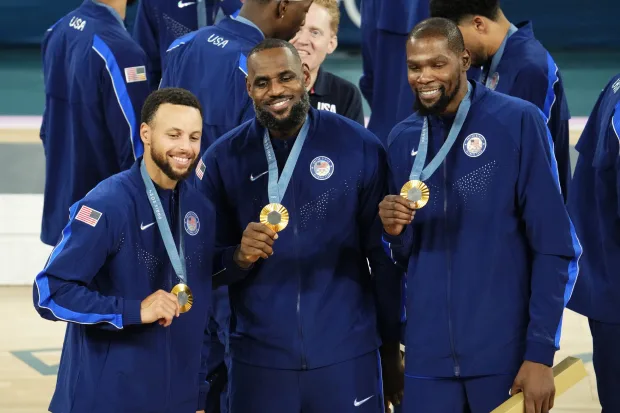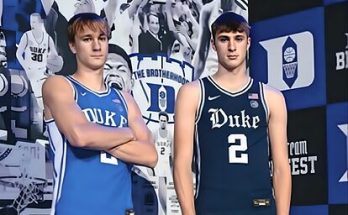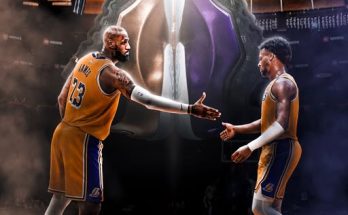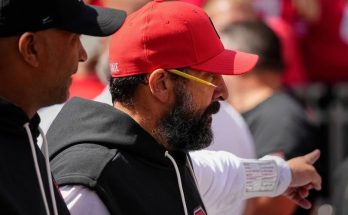In the annals of NBA history, the concept of a “superteam”—a roster stacked with multiple superstar talents—has both dazzled fans and dominated championships. The Golden State Warriors, a franchise synonymous with this phenomenon, have been at the epicenter of such discussions, especially with their ambitious attempts to unite Stephen Curry, LeBron James, and Kevin Durant. This trio, each a generational talent, playing together in the Bay Area, was a tantalizing prospect that, despite earnest efforts, remained an unfulfilled dream.
The Genesis of the Superteam Era
The Warriors’ foray into superteam territory began in earnest during the 2016 offseason. Fresh off a record-setting 73-win regular season but a heartbreaking NBA Finals loss to LeBron James’ Cleveland Cavaliers, Golden State sought reinforcements. They successfully recruited Kevin Durant, a former MVP and perennial All-Star, from the Oklahoma City Thunder. Durant’s addition to a core already boasting Stephen Curry, Klay Thompson, and Draymond Green resulted in a basketball juggernaut. This ensemble clinched back-to-back championships in 2017 and 2018, redefining the league’s competitive landscape.
The Allure of LeBron James
LeBron James, often compared to legends like Michael Jordan, has been both a rival and a respected peer to the Warriors. His battles against Golden State in four consecutive NBA Finals (2015-2018) are etched in basketball lore. The mutual respect between James and Curry fueled speculations about a potential alliance. These rumors gained traction during the 2024 offseason when reports surfaced about the Warriors’ interest in acquiring James. According to ESPN, Golden State explored a deal with the Los Angeles Lakers to bring James to the Bay Area before the trade deadline. However, these discussions did not materialize into a trade.
The 2024 Offseason: Renewed Ambitions
The 2024 offseason was a period of introspection and ambition for the Warriors. With their championship window perceived to be narrowing, the front office, led by owner Joe Lacob, sought to rejuvenate the roster. The idea of reuniting with Kevin Durant, who had departed for the Brooklyn Nets in 2019, resurfaced. Simultaneously, the prospect of bringing LeBron James into the fold was revisited. The vision was audacious: a lineup featuring Curry, James, and Durant—a trio that could potentially dominate the league.
However, several obstacles stood in the way. LeBron James possessed a no-trade clause and had previously expressed his commitment to the Lakers. Reports indicated that James had no interest in a trade and wanted to remain a Laker. Additionally, Durant’s previous departure from Golden State was influenced by complex dynamics, including reported tensions within the team. Reintegrating him posed both logistical and relational challenges.
Financial and Logistical Hurdles
Constructing a superteam with three max-contract players requires navigating a labyrinth of financial constraints. The NBA’s salary cap and luxury tax provisions are designed to promote competitive balance, making the assembly of multiple superstars on a single roster a formidable task. The Warriors, already operating with a significant payroll, would have faced severe luxury tax penalties. This financial strain would necessitate difficult decisions, potentially involving the trade of key role players or even core members like Klay Thompson or Draymond Green to accommodate the salaries of James and Durant.
The Human Element
Beyond the financials and logistics, the human aspect plays a pivotal role in team dynamics. Stephen Curry, the Warriors’ cornerstone, has always emphasized team chemistry and culture. In interviews, Curry has expressed openness to playing with elite talents but also underscored the importance of fit and mutual respect. Regarding the possibility of teaming up with James and Durant, Curry stated, “You can never say never, but as it stands, we’re all competitors and focused on our own teams.”
Moreover, Draymond Green, a vocal leader and integral part of the Warriors’ identity, shares a close friendship with LeBron James. While Green reportedly advocated for James’ acquisition, the complexities of blending strong personalities and ensuring cohesive locker room dynamics cannot be overstated.
The Road Not Taken
Despite the allure and the concerted efforts, the envisioned superteam of Curry, James, and Durant did not come to fruition. The Lakers, committed to their partnership with LeBron, were unwilling to entertain trade discussions. Similarly, Durant remained with the Brooklyn Nets, focusing on his journey there. The Warriors, while ambitious, recognized the importance of maintaining financial flexibility and team harmony.
Legacy and Reflection
The pursuit of this dream team, though unrealized, speaks volumes about the Warriors’ commitment to excellence and their proactive approach to team building. It also highlights the evolving nature of player relationships and the modern NBA landscape, where superstars wield significant influence over their destinies.
In retrospect, the Warriors’ attempts to assemble such a formidable trio underscore the franchise’s dedication to exploring all avenues for success. While the Curry-James-Durant superteam remains a captivating “what if” scenario, the efforts reflect the dynamic and ambitious spirit that has come to define Golden State’s approach in the modern NBA era.
The Warriors’ Dream Team That Never Was: A Closer Look at the Missed Opportunity
In the annals of NBA history, the concept of a “superteam” has both dazzled fans and dominated championships. The Golden State Warriors, a franchise synonymous with this phenomenon, have been at the epicenter of such discussions, especially with their ambitious attempts to unite Stephen Curry, LeBron James, and Kevin Durant. This trio, each a generational talent, playing together in the Bay Area, was a tantalizing prospect that, despite earnest efforts, remained an unfulfilled dream.
The Genesis of the Superteam Era
The Warriors’ foray into superteam territory began in earnest during the 2016 offseason. Fresh off a record-setting 73-win regular season but a heartbreaking NBA Finals loss to LeBron James’ Cleveland Cavaliers, Golden State sought reinforcements. They successfully recruited Kevin Durant, a former MVP and perennial All-Star, from the Oklahoma City Thunder. Durant’s addition to a core already boasting Stephen Curry, Klay Thompson, and Draymond Green resulted in a basketball juggernaut. This ensemble clinched back-to-back championships in 2017 and 2018, redefining the league’s competitive landscape.
The Allure of LeBron James
LeBron James, often compared to legends like Michael Jordan, has been both a rival and a respected peer to the Warriors. His battles against Golden State in four consecutive NBA Finals (2015-2018) are etched in basketball lore. The mutual respect between James and Curry fueled speculations about a potential alliance. These rumors gained traction during the 2024 offseason when reports surfaced about the Warriors’ interest in acquiring James. According to ESPN, Golden State explored a deal with the Los Angeles Lakers to bring James to the Bay Area before the trade deadline. However, these discussions did not materialize into a trade.
The 2024 Offseason: Renewed Ambitions
The 2024 offseason was a period of introspection and ambition for the Warriors. With their championship window perceived to be narrowing, the front office, led by owner Joe Lacob, sought to rejuvenate the roster. The idea of reuniting with Kevin Durant, who had departed for the Brooklyn Nets in 2019, resurfaced. Simultaneously, the prospect of bringing LeBron James into the fold was revisited. The vision was audacious: a lineup featuring Curry, James, and Durant—a trio that could potentially dominate the league.
However, several obstacles stood in the way. LeBron James possessed a no-trade clause and had previously expressed his commitment to the Lakers. Reports indicated that James had no interest in a trade and wanted to remain a Laker. Additionally, Durant’s previous departure from Golden State was influenced by complex dynamics, including reported tensions within the team. Reintegrating him posed both logistical and relational challenges.
Financial and Logistical Hurdles
Constructing a superteam with three max-contract players requires navigating a labyrinth of financial constraints. The NBA’s salary cap and luxury tax provisions are designed to promote competitive balance, making the assembly of multiple superstars on a single roster a formidable task. The Warriors, already operating with a significant payroll, would have faced severe luxury tax penalties. This financial strain would necessitate difficult decisions, potentially involving the trade of key role players or even core members like Klay Thompson or Draymond Green to accommodate the salaries of James and Durant.
The Human Element
Beyond the financials and logistics, the human aspect plays a pivotal role in team dynamics. Stephen Curry, the Warriors’ cornerstone, has always emphasized team chemistry and culture. In interviews, Curry has expressed openness to playing with elite talents but also underscored the importance of fit and mutual respect. Regarding the possibility of teaming up with James and Durant, Curry stated, “You can never say never, but as it stands, we’re all competitors and focused on our own teams.”
Moreover, Draymond Green, a vocal leader and integral part of the Warriors’ identity, shares a close friendship with LeBron James. While Green reportedly advocated for James’ acquisition, the complexities of blending strong personalities and ensuring cohesive locker room dynamics cannot be overstated.
The Road Not Taken
Despite the allure and the concerted efforts, the envisioned superteam of Curry, James, and Durant did not come to fruition. The Lakers, committed to their partnership with LeBron, were unwilling to entertain trade discussions. Similarly, Durant remained with the Brooklyn Nets, focusing on his journey there. The Warriors, while ambitious, recognized the importance of maintaining financial flexibility and team harmony.
The Impact on the NBA Landscape
Had the Warriors succeeded in assembling this superteam, the ramifications on the NBA landscape would have been profound. The league has already experienced its share of dominant teams, from the 1990s Chicago Bulls to the early 2000s Los Angeles Lakers. A Curry-LeBron-Durant trio would have likely ushered in another era of dominance, potentially overshadowing teams like the Denver Nuggets, Boston Celtics, and Milwaukee Bucks. The competitive balance, which the league has worked to maintain, could have been disrupted significantly.
The Warriors’ attempt also underscores a broader trend in the modern NBA—player empowerment and the fluidity of team rosters. Superstars now wield more influence than ever, dictating their career paths and forming alliances that shape the league’s power structure. The fact that the Warriors even explored this possibility speaks to their aggressive and forward-thinking front office strategy.
Comparisons to Other Superteam Attempts
The NBA has seen various attempts to form superteams, some more successful than others. The Miami Heat’s “Big Three” of LeBron James, Dwyane Wade, and Chris Bosh delivered two championships in four years. The Brooklyn Nets’ trio of Durant, James Harden, and Kyrie Irving, however, failed to meet expectations due to injuries and chemistry issues.
Golden State’s attempt to bring together Curry, LeBron, and Durant would have likely faced similar challenges. While the talent level was undeniable, integrating three high-usage superstars while maintaining a functional system would have required sacrifices. Coaching, role definition, and egos would have all played significant roles in determining success or failure.
Legacy and Reflection
The pursuit of this dream team, though unrealized, speaks volumes about the Warriors’ commitment to excellence and their proactive approach to team building. It also highlights the evolving nature of player relationships and the modern NBA landscape, where superstars wield significant influence over their destinies.
In retrospect, the Warriors’ attempts to assemble such a formidable trio underscore the franchise’s dedication to exploring all avenues for success. While the Curry-James-Durant superteam remains a captivating “what if” scenario, the efforts reflect the dynamic and ambitious spirit that has come to define Golden State’s approach in the modern NBA era.



